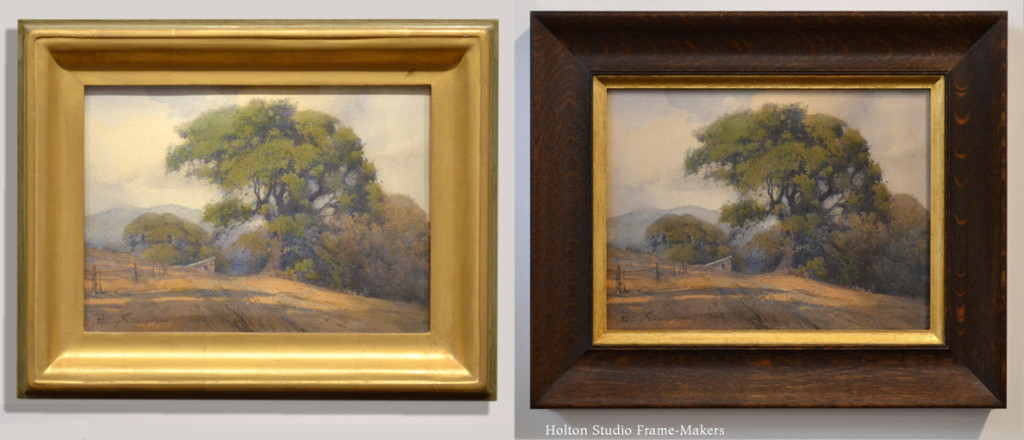Here’s a new before-and-after for the webpage, “Fixing a ‘Very Prevalent Error’: The Cabinetmaker’s Answer to the Gold Frame Convention”. This is a wonderful 1914 watercolor by Percy Gray. Asking of you a little imagination, I hope this comparison gives a sense of not only the more harmonious effect of the wood frame, but its capacity to connect the picture to an architectural setting—and therefore to the viewer—rather than isolate the picture in its own private, ethereal place. (Go to “Fixing a ‘Very Prevalent Error’: The Cabinetmaker’s Answer to the Gold Frame Convention”.)
This is a key idea for me in designing framing. And it’s an ideal close to the hearts of those influenced by the Arts and Crafts Movement and design reform who were gravely concerned about the place of painting in relation to the other arts.

Percy Gray, “California Hillside,” 1914. Watercolor, 11″ x 15″. Before and after re-framing. Framed in No. 308.2 — 2-5/8″ in quartersawn white oak (Medieval Oak stain), with gilt ogee liner.
To give one example: The year after this painting was done, San Francisco hosted the Panama-Pacific International Exhibition. (The DeYoung Museum in San Francisco is currently celebrating the centennial of this event with an exhibition of much of the painting and sculpture displayed there.) Eugene Neuhaus, who was chairman of the Advisory Committee of the Department of Art for the Exposition and a member of the International Jury of Awards there, complained of the difficulty posed by modern paintings of creating a cohesive display when such works all compete with each other, each striving for a kind of isolated existence enabled by a gilt setting meant above all to separate it from its surroundings. In his book, Galleries of the Exhibition, the UC Berkeley professor wrote:
The one thing that can be said of all paintings made before [the renaissance] is that they were painted for a practical purpose. They had to fit into certain physical conditions, architectural or other. Most modern paintings are simply painted on a gambler’s chance of finding suitable surroundings afterwards. Nowadays a picture is produced with the one idea of separating it from the rest of the world by a more or less hideous gold frame, the design of which in many cases is out of all relation to the picture as well as to the wall. In fact, most frames impress one as nothing but attempts to make them as costly as possible.
I imagine that practically all true painters would rather do their pictures under and for a given physical condition, to support and be supported by architecture; but with the unfortunate present-day elimination of paintings from most architectural problems, most artists have to paint their pictures for an imaginary condition. The present production of paintings has become absolutely unmindful of the true function of a painting, which is to decorate in collaboration with the other arts — architecture and sculpture.
Neuhaus’s concern was consistent with the thought of Arts and Crafts architects like MH Baillie Scott, who wrote,
It would be interesting to inquire how far the art of picture painting is coincident with the decline of Art in its widest interpretation, representing the last stronghold of the artist driven from the service of life behind the gilded pale of the picture frame, where he dreams in a little shadow world all his own.
You might say, well, it’s only a picture frame. Yes, but the picture frame is a particularly tangible expression of an extraordinarily profound problem: the place of art. Shall the arts be connected and a part of our lives, or set apart and isolated? A central concern of the Arts and Crafts Movement, reformers sought, in a very real sense, to re-frame art—to reform the place of art and restore it to the “service of life”. As this picture’s period framing (probably not the artist’s choosing) shows, they had limited success. Nevertheless, Mr Gray has asked us to consider something very much deserving of not only our consideration, our contemplation and our due regard, but our deepest reverence: the landscape of California and our lives on it. That is something for our own lives to connect to—as he connected with it in creating this picture.
How we frame things we revere — things we claim as praise-worthy and worthy of hanging on our walls to frame our lives — reflects their genuine connectedness, their real meaning, to us; and how much they truly inform, inspire and serve our lives.
Once again, Ruskin:
« Back to Blog“Have you considered, in the early history of painting, how important also is the history of the frame-maker? It is a matter, I assure you, needing our very best consideration.”